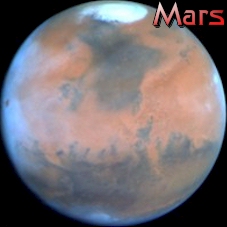

![]()
|
Mars is the god of War. In Greek mythology, he is known as Ares. The planet probably got this name due to its red color; Mars is sometimes referred to as the "Red Planet." The name of the month March derives from Mars. |

|
This is the
symbol for Mars:
|
|
|
|
Mars comes in second place (Earth being in first) for having the most highly varied and interesting terrain of any of the terrestrial planets. Check out some of these spectacular features: |
|
|
|
|
Olympus Mons - The largest mountain in the Solar System! Olympus Mons rises a full 24 km (78,000 ft.) above the surrounding plain. Its base is more than 500 km across and is rimmed by a cliff 6 km (20,000 ft) high! |
|
|
|
|
Hellas Planitia - A huge impact crater in the southern hemisphere. It's over 6 km deep and 2000 km across! |
|
|
|
|
Valles Marineris - A network of canyons that run 4000 km long and stand from 2 to 7 km tall! |
|
|
|
|
Tharsis - A huge bulge on the Martian surface. It's about 4000 km across and 10 km high! |
|
Though there is no water on Mars now, it is thought that large lakes or even oceans may have once existed on this planet. Clear evidence of water erosion can be seen in old river channels and floodplains. It seems that water was only around for a very short while and very long ago. |
|
|
|
|
|
|
|
Look for Mars! When it is in the nighttime sky, Mars is easily visible with the naked eye. Its brightness varies greatly depending on where it is relative to the Earth. |